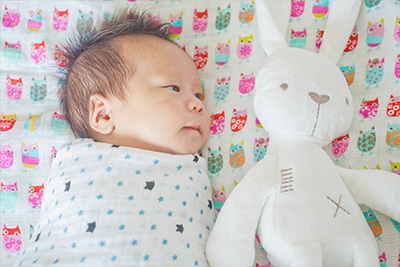Published on March 28th, 2022 and Updated on February 21st, 2025
Check out SneakPeek Gender Test to find out your baby’s gender as early as 6 weeks at over 99% accuracy1!

Imagine this—you tiptoe into your baby’s nursery late one night to check on her. The room is dark and quiet, save for the whir of the sound machine on the nightstand. You lean over the crib to find your sweet little darling sound asleep… with her eyes wide open. Like a tiny freakin’ zombie.
Until now, you thought your pregnancy mucus plug was the creepiest thing you’d see on this whole parenting journey. Well, friend, allow us to introduce you to some stiff competition to that—infant nocturnal lagophthalmos.
Before you rush to call Father Merrin, we can allay some of your fears immediately. Infants sleeping with their eyes wide open or slightly open during bedtime is totally normal and actually pretty common. Your young baby likely does not have a sleep disorder. Although nocturnal lagophthalmos is not a cause for concern (in most cases), understanding the why’s, when’s, and how’s will help you better understand your infant’s sleep habits and patterns. So, read on if you have a little zombie in your nursery.
What is infant nocturnal lagophthalmos?
According to the American Academy of Ophthalmology, lagophthalmos is the medical term for the incomplete or defective closure of the eyelids. When it occurs at night, it’s called nocturnal lagophthalmos. While lagophthalmos in adults bears investigation by a medical professional to rule out a causal medical condition, lagophthalmos in infants is almost always physiological (meaning it’s a normal process and there’s no underlying medical cause) and eventually outgrown, so those open eyes are usually nothing to be worried about.
Because infant physiological lagophthalmos is both a temporary and benign condition, research into its cause is relatively scant. There is some evidence that it may be:
- Hereditary
- Related to the developing nervous system
- Asymptomatic (meaning there are no secondary symptoms caused by sleeping with the eyes open)
Research has identified that physiological nocturnal lagophthalmos is connected to REM sleep. This means that when you see your baby sleeping with his eyes open, he’s most likely in the REM sleep phase. What does that mean?
What is REM sleep?
Humans cycle between two stages of sleep:
- REM sleep
- Non-REM sleep
REM stands for rapid eye movement which is, quite literally, what’s happening during this sleep phase.
During REM sleep, the eyes move rapidly—up, down, and side to side—but don’t send any visual information to the brain. In most people, this action occurs behind closed lids. Dreams typically happen during this phase of sleep. While the eyes are active, the rest of the body is essentially paralyzed.
On the other hand, non-REM sleep (sometimes called NREM or non-rapid eye movement) refers to the stage of sleep that occurs between cycles of REM. Adults and babies over six months old experience three phases of NREM sleep, and they always occur in order:
- Phase 1 – The transition period from wakefulness to sleep, this phase is the first and lightest phase of sleep that lasts between 5 and 15 minutes. It’s usually very easy to wake a sleeper from this phase, and their muscles may randomly twitch during it. If your baby is twitching in sleep, this is most likely normal, too.
- Phase 2 – This phase is characterized by a slowing of the heart rate, lowering of body temperature, and production of sleep spindles (bursts of coherent activity) by the brain. Still considered a light sleep phase, this phase lasts between 15 and 25 minutes.
- Phase 3 – This is the deepest phase of sleep, when muscles are deeply relaxed and the breathing rate drops even further. It’s difficult to rouse a sleeper from this state—if they are awakened, they feel disoriented. It’s during this deep sleep phase that the body works to repair itself.
Although adults and babies over six months share the same four sleep phases, the amount of time spent in each phase changes drastically with age.
In adults, REM sleep follows the onset of NREM sleep and lasts approximately 10 minutes for the first sleep cycle, with each subsequent REM period lasting slightly longer. On average, adults spend about 20% of their total sleep time in REM sleep.
Babies, however, spend about 50% of their sleep time in REM sleep.
Why the big difference? What makes REM sleep (and its potential accompanying zombie goo-goo eyes) so important for babies?
The Importance of REM Sleep For Infants
REM sleep is very different from the other three phases of sleep. Not only is this stage associated with dreaming and muscle paralysis, but it’s also the stage in which the brain is most active. REM sleep stimulates the areas of the brain that work to:
- Learn skills
- Make neural connections
- Retain memories
Research has shown that REM sleep is the phase in which the sleeping brain actively converts waking experiences into lasting long-term memories. For a tiny baby who’s just encountering the world, this experience to memory pathway is critical. This means REM sleep is key to your baby’s ability to learn, process, and store important information.
Best Sleep Practices For Infants
So, let’s review: babies need lots of REM sleep time, but if your baby has nocturnal lagophthalmos, REM sleep time is also eyes-wide-open-at-night time. Where does that leave you as a parent? Frankly, in a support role, you’re now zombie support staff.
All jokes aside, whether you find your little one’s nocturnal lagophthalmos interesting, creepy, or somewhere in between, you can help her get the best quality sleep she can—eyes open or shut.
Tips for Creating A Snoozy Nursery
Good, quiet sleep begins in a smartly-curated nursery—one that ensures the best possible environment for a restful, REM-filled night.
Some basic supplies for a sleep-nurturing nursery are:
- Crib – A sturdy, versatile structure that supports a well-fitted infant mattress should be the primary element in your nursery. Avoid bumpers, loose blankets, and pillows until your child is physically capable of navigating them, generally after 1 year of age. For more detail, check out our guide on when can babies have a pillow, and when can babies sleep with a blanket.
- Crib sheets – A high-quality, well-fitted crib sheet will keep your baby comfortable while maintaining safety.
- Sleep sack – Consider dressing your little one in a sleep sack or swaddle to help keep him extra cozy. Don’t use loose blankets or comforters, as your baby could choke on or become tangled in them.
- Blackout curtains – Blackout curtains or room-darkening shades are important for when your little one is sleeping during bright daytime hours.
- White noise machine – Some babies respond well to the background din created by a white noise machine. In fact, the whooshing and whirring of white noise machines mimic the sounds your baby heard in mom’s womb, which can provide a sense of familiar comfort.
- Monitor – The benefit of a baby monitor is that you won’t have to step into the nursery to check on your little one and potentially stir him from sleep.
Tricks for Getting Into Good Sleep Habits
In addition to curating a healthy baby sleep environment, fostering healthy sleep habits can help your little one fall asleep easier and stay asleep longer. While creating and maintaining healthy sleep habits can be tricky, especially in those early months, the effort you put into creating a solid sleep bedtime routine now will pay you back tenfold as your baby grows.
Several tried-and-true sleep routine elements you can implement before nap and bedtime are:
- Giving your baby a warm bath
- Lightly massaging with lotion
- Reading or singing lullabies in a calm, low voice
- Rocking and cuddling
- Avoiding nighttime feeding
Nocturnal Lagophthalmos Support
If you’re still concerned about your baby’s tendency to sleep with eyes wide open, don’t hesitate to contact your pediatrician. While rare, there are some medical conditions, such as congenital eyelid abnormalities, that can be easily ruled out through examination.
In the meantime, if your baby sleeps with eyes open, and it continues to bother you, it’s perfectly safe and acceptable to use (sanitized) fingertips to gently push her eyelids down once she’s asleep.
You can also:
- Use a humidifier – If you’re worried that your sweet pea’s nocturnal lagophthalmos might be drying and irritating her eyes, place a humidifier in the nursery.
- Learn to love the zombie – Remember, this too shall pass. Research shows that most newborn babies outgrow their nocturnal lagophthalmos well before their first birthday.
At the end of the day, leaning down to check on your soundly sleeping newborn only to find his eyes wide open can be a shocking moment. But truth be told, it’s probably not the first or last shock of your parenting journey.
Editorial Policy
At SneakPeek, our commitment is to provide accurate, up-to-date, and reliable information to empower our readers. Our content is thoroughly researched, reviewed by medical experts, and fact-checked to ensure its credibility. We prioritize the well-being and education of our readers, and our editorial policy adheres to the highest standards of integrity and accuracy in all our articles.
This post has been reviewed for accuracy by:
Haley Milot, a highly skilled laboratory professional, currently serves as the Associate Director of Lab Operations at Gateway Genomics, the parent company of SneakPeek. Her extensive experience in laboratory management, spanning over seven years with Gateway Genomics, showcases her expertise in quality assurance, quality control, and the development of laboratory procedures. Haley's background includes pivotal roles in DNA extraction and purification, real-time qPCR, and specimen accessioning, underscoring her comprehensive understanding of laboratory operations and diagnostics. Her adeptness in managing complex laboratory functions and her deep knowledge of medical diagnostics make her a vital contributor to SneakPeek's innovative approach to prenatal testing.
Sources:
- American Academy of Ophthalmology. Sleeping With Eyes Open. https://www.aao.org/eye-health/tips-prevention/sleeping-with-eyes-open
- HealthLine. My Baby Sleeps With Eyes Open. Is This Normal? https://www.healthline.com/health/baby/baby-sleeps-with-eyes-open#is-it-normal
- Journal Clinical Sleep Medicine. When Sleeping With Eyes Closed Is Optional. https://www.ncbi.nlm.nih.gov/pmc/articles/PMC6778343/
- WebMD. What Are REM and Non-REM Sleep? https://www.webmd.com/sleep-disorders/sleep-101
- National Institutes of Health. Understanding Sleep. https://www.ninds.nih.gov/Disorders/Patient-Caregiver-Education/Understanding-Sleep
- Harvard Medical School Sleep Division. Changes In Sleep With Age. https://healthysleep.med.harvard.edu/healthy/science/variations/changes-in-sleep-with-age
- Sleep Association. REM Sleep: Why Is It Important? https://www.sleepassociation.org/about-sleep/stages-of-sleep/rem-sleep/
- Science Daily. REM Sleep Critical For Young Brain Development. https://www.sciencedaily.com/releases/2015/07/150703150206.htm#:~:text=The%20study%20suggests%20that%20during,from%20their%20environment%2C%20he%20said.
- BMJ Case Reports. Nocturnal lagophthalmos: never seen before in hypernatraemic dehydration. https://www.ncbi.nlm.nih.gov/pmc/articles/PMC3987541/
- ScienceDirect. Nocturnal Lagophthalmos. https://www.sciencedirect.com/science/article/pii/S1873959809700274







